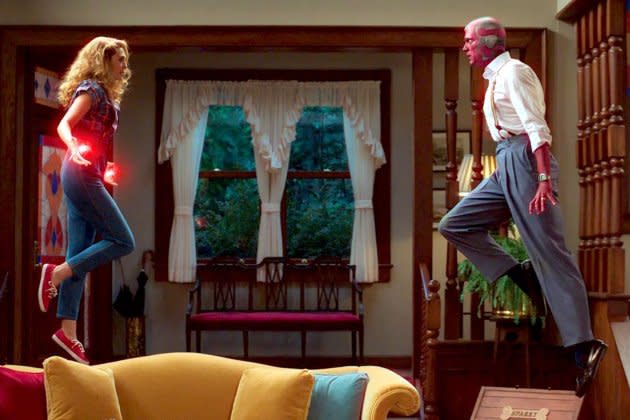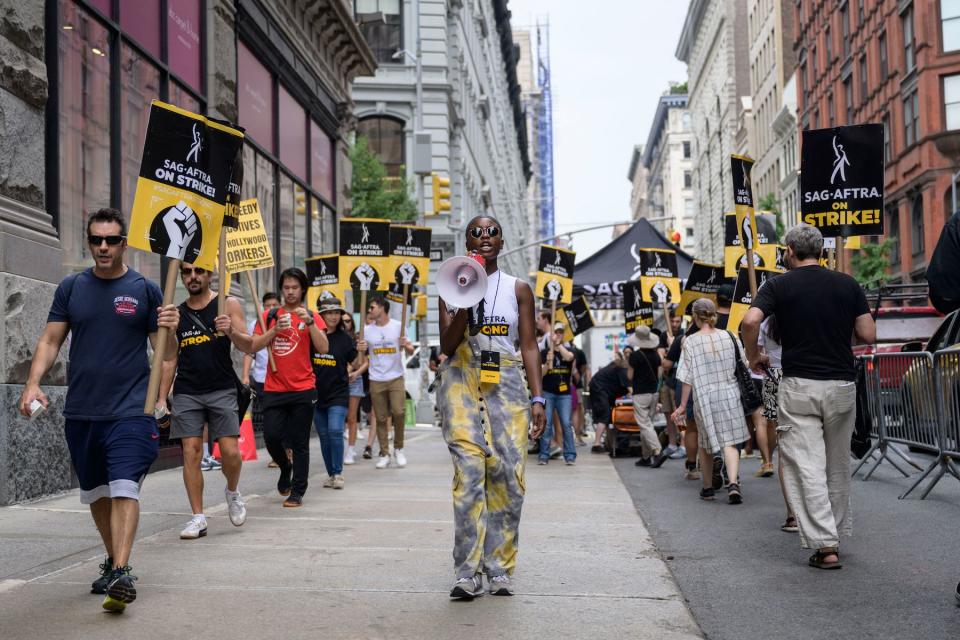Marvel VFX Workers Fight to Change Company’s ‘Live at Work’ Culture

When Mark Patch started as a visual effects coordinator on WandaVision, he saw it as a great opportunity. It was November 2020, and he’d been out of work for four months due to the pandemic. Working on Marvel’s first scripted show for Disney+, starring Elizabeth Olsen and Paul Bettany, felt like working on a 10-hour movie in half the time, Patch says. He worked 16-hour shifts, skipping break periods and spending his lunchtime scanning set designs and costumes while the crew enjoyed their midday meals. Patch quit after just eight days.
“It was ‘live at work,’” Patch says. “From the second we woke up in the morning until midnight.”
More from Rolling Stone
'Blue Beetle' Is the Same Old DCEU Superhero Movie - With One Big Difference
SAG Clarifies What Movie and TV Shoots Will Be Permitted During Strike
Patch’s experience echoes the poor working conditions other visual effects professionals have faced while working on Marvel productions. In response to a lack of pay equity, protected hours, and fair turnaround times, visual effects crews at Marvel Studios voted to unionize Aug. 7, and indicated they’d like the International Alliance of Theatrical Stage Employees (IATSE) to represent them. A supermajority of more than 50 Marvel visual effects crew members, which refers to 80% of Marvel employees who were on the payroll a week prior to the petition, signed authorization cards stating they’d like the union’s representation, and a vote to certify the union is currently set for Aug. 21 with a Sept. 11 deadline. (Marvel/Disney did not respond to requests for comment.)
The vote marks a historic step for visual effects workers, whose field has grown astronomically since the first Star Wars film in the 1970s, but have remained without a union. To Patch and other visual effects artists, there would be no Avengers or Star Wars franchise without them. As actors and writers picket for fairer wages and AI protections, visual effects workers hope to unionize and anticipate future changes that include health benefits, pensions, meal penalties, and overtime compensation.
“We’ve seen [that] the lack of guardrails and protections has created an environment where the employer has unlimited control of our whole lives,” says Patch, who is now a full-time IATSE visual effects organizer.
For James Dornoff, who has worked on Marvel productions like Captain America: The Winter Soldier, Doctor Strange, and Eternals, he says he turned down a gig with Avengers: Endgame as a data wrangler, who captures on-set photos for visual effects artists, after learning he would only make $850 a week. To put it into perspective, a data wrangler working for a visual effects company makes about $2,850 a week, according to a 2022 IATSE working conditions survey. Once he began to calculate the taxes from his paycheck and total hours worked, ranging from 12 to 18 hours a day, he says he wouldn’t even make minimum wage.
“The comeback is, ‘Well, you’re going to be on a Marvel project and that’s gonna be really good for your resume,’” Dornoff says.
Over and over again, visual effects workers have complained to the media about Marvel’s grueling work hours, understaffed teams, and excessive requests for changes. But Marvel has only continued to ramp up its film and TV schedule: the Marvel Cinematic Universe’s Phase Five, which includes productions released from 2023 to 2025, will include seven feature films and seven TV shows, unlike Phase One, which ran from 2008 to 2012 and ended with just 6 films.
In order to produce their visual effects, Marvel outsources visual effects studios, and each studio often enters into a bidding war to win a contract with the superhero film franchise. One visual effects artist, who worked 64-hour weeks, told Vulture that the bids often led to understaffed projects, with some workers experiencing mental breakdowns and anxiety attacks.
“It ends up burning us out,” Dornoff adds.

One visual effects producer, who preferred to go by Emily* to remain anonymous, says she faced discrimination when interviewing for a role on Black Panther. A producer on the project repeatedly questioned her marital status, plans to have children, and her husband’s occupation given that the production involved working abroad. Emily says these topics were brought up three to four times during a half-hour interview.
After reassuring the producer that she was prepared to relocate, and had previously worked abroad for other projects, she was denied the position and offered a lower one at a local level.
“You’re not allowed to have a husband or a partner or kids when you work for Marvel or in visual effects?” Emily says, “That’s ridiculous.”
Afterward, Emily confided in Maggie Kraisamutr, who has spent two decades of her career in visual effects. Kraisamutr says she was shocked to learn that it had occurred with Marvel Studios, especially since she’s worked for Disney, the parent company, for about five years. She has steered clear from working on Marvel projects, even after receiving recommendations from crew members on Black Panther and Doctor Strange, and the nightmare stories from Marvel crews have encouraged her to become an IATSE volunteer organizer and advocate for a visual effects union. Just as IATSE has represented 168,000 members who work as camera operators, hair and makeup artists, and production designers, Kraisamutr says she hopes visual effects workers will receive the same labor rights such as overtime protections, health benefits, pensions, and pay equity.
“Everyone else seems to have a union,” Kraisamutr says. “Where’s this visual effects union?”
Best of Rolling Stone

